
© » KADIST
Richard T. Walker
let this be us is a single-channel video by Richard T. Walker featuring the artist himself roaming around the wilderness of a deserted landscape, sporadically humming a melody, strumming a guitar, or playing a few notes on a keyboard. As he traverses between striking locations we see him carrying large photographic prints of the same landscape that he is treading, which he then rests onto tripods so that the horizon in the photograph seamlessly matches that of the real landscape. As we hear the music, Walker comes in and out of view, dissipating into the landscape as his body becomes invisible, hidden behind the photographic prints.

© » KADIST
Richard Bell
For Richard Bell, art is not simply a vehicle through which to represent and convey political content. On one hand, art itself has an activist charge—in its very form and presence it can shake up conventional or assumed understandings, opinions, and behaviours. But on the other hand, it is deeply implicated in the actions and attitudes associated with colonialism in Australia and abroad.

© » KADIST
Richard Gordon
Washington D. C. Constitution Ave. is a silver gelatin print from the series American Surveillance , a ten-year-long project where Richard Gordon photographed surveillance cameras across USA. In the image, a woman and a child walk along Constitutional Avenue as a surveillance camera on the street post directs its gaze towards them. The otherwise quiet image then becomes an exercise of resistance: together with the other images from the series, Gordon’s photograph documents the changes that have taken place in architecture, civic life, especially in a post 9/11 experience of public space.
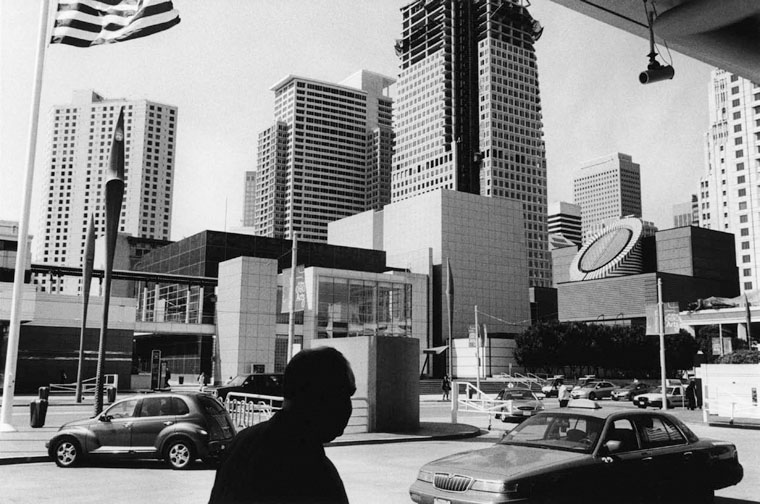
© » KADIST
Richard Gordon
San Francisco, Moscone Center is a silver gelatin print from the series American Surveillance , a ten-year-long project where Richard Gordon photographed surveillance cameras across USA. In the image’s foreground we see the silhouette of a man, darkened and in contrast to the bright streetscape unfolding behind him. To the left, an American flag flutters in the wind, saluting the skyscrapers—among them the iconic architecture of the San Francisco Museum of Modern Art.

© » KADIST
Kelley Walker
The triptych Black Star Press is part of the series ‘The Black Star Press project’ initiated in 2004 by the American artist Kelley Walker. The images in this series are taken from a photo essay on the struggle for civil rights in Alabama, directed by Charles Moore in 1962 (and published by the magazine ‘Life’) which showed the repression of the black population and persistent inequalities in the southern United States. The title “Black Star Press” is taken from the name of the news agency where Charles Moore worked, and it refers to the young black man shot fighting for the rights of his community.

© » KADIST
Kara Walker
In her masterpiece 8 Possible Beginnings or The Creation of African-America , Walker unravels just that, the story of struggle, oppression, escape and the complexities of power dynamics in the history following slave trade in America. Her use of contour and silhouette accentuate emotion with rigor, she reduces the narrative to black and white as gruesome acts of sex and violence address trauma, fear and suffering through a majestic play of shadow and light.

© » KADIST
James T. Hong
Lessons of the Blood by James T. Hong pieces together interviews, extensive archival and field research, and TV footage addressing Japan’s use of biological warfare and experimentation on Chinese prisoners during World War II, as well as the revisionism of the Japanese government and Chinese survivors’ attempts to live with this horrific history and to find justice. Co-written, directed, edited and produced with Yin-Ju Chen, whose work is also represented in the Kadist collection, Lessons of the Blood is a meditation on propaganda, the ways in which national mythologies can literally infect and poison the most vulnerable among us, and the legacy of World War II in China, presented through the testimonies of survivors, academics, medical experts, nationalists and activists. The film locates its genesis in the publication of the New History Textbook in Japan in 2000, which infamously glossed over the Japanese Empire’s wartime atrocities, sparking rage and violent protests in China and South Korea in 2005.

© » KADIST
James T. Hong
Taiwan WMD (Taiwan and Weapons of Mass Destruction) is part of a long-term research started in early 2010 on the history and aftermath effects of Japanese biological and chemical warfare in China during WWII, as well as the unknown history of Taiwan’s nuclear program. T. Hong’s research is not only an effort to revisit a dark time that complicates certain histories, but more importantly an investigation of how violence is enacted in the name of rationality.

© » KADIST
Volker Eichelmann
In his new series of collages, Eichelmann takes his starting point from the “Belvedere Torso” in the Vatican Museum. In taking over and consuming the image of the sculpture, Eichelmann deconstructs its appearance by cutting it up, covering it, rendering the sculpture an allegorical ruin. Subverting the autonomy of the ancient sculpture in art history, Eichelmann creates a palimpsest through adding a new layer to the work in deconstructing and collapsing the famous sculpture.
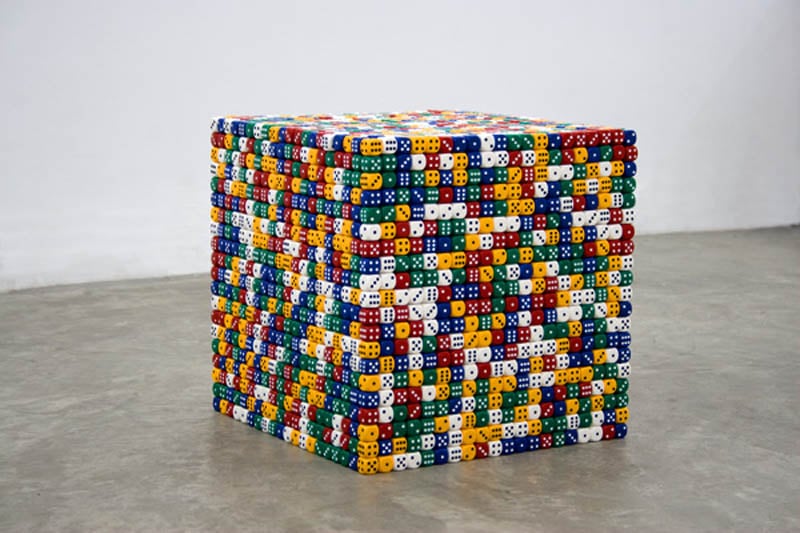
© » KADIST
Evariste Richer
Cumulocumulonimbus capillatus incus functions on the mode of a mise en abîme: it is a cube composed with 8000 dice. The work plays with chance, each installation produces a renewed visual combination. Robert Filliou said that Eins.
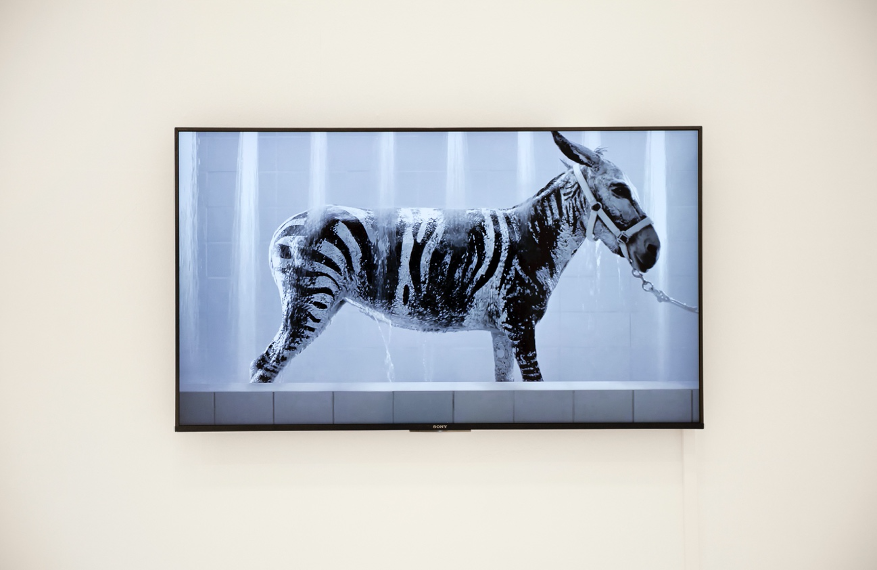
© » KADIST
Sharif Waked
Bath Time by Sharif Waked is a short video based on the tragi-comic outcome of the Israeli Blockade and the wars in Gaza. The story tells about how, after a war and the ongoing economic pressure, the Gaza Zoo lost several of their animals, and decided that they could paint a donkey so that it could pose as a zebra. The video imagines the donkey in the shower after a shift impersonating a zebra at the Gaza Zoo, as the hot water slowly washes its faux stripes away.
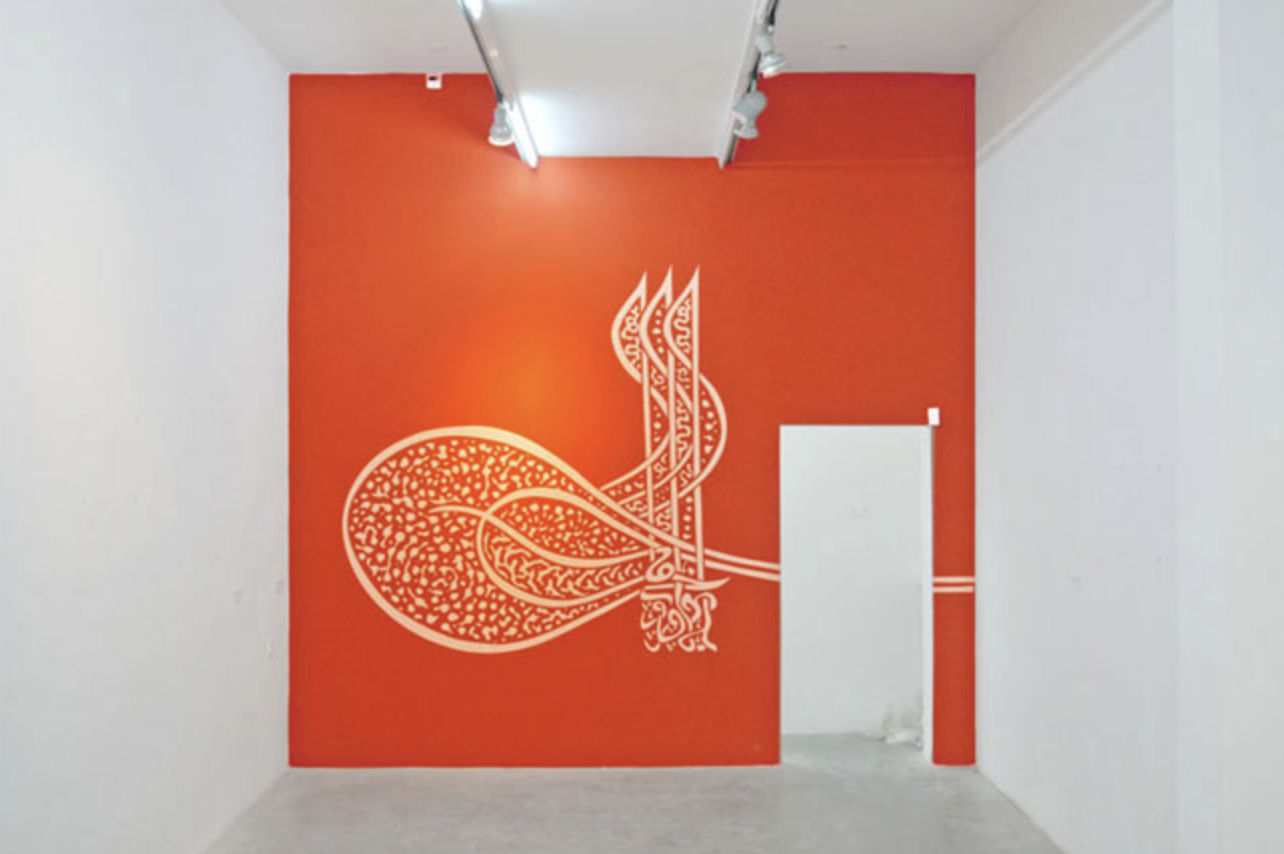
© » KADIST
Sharif Waked
Tughra is a protocol by Sharif Waked that reproduces the sixteenth century calligraphic monogram for tughra ; also known as the signature of Suleiman the Magnificent. Under Suleiman’s reign, at the beginning of the 16th century, the Ottoman empire achieved its apex both in terms of territorial extension and cultural creation. Suleiman personally instituted major judicial changes relating to society, education, taxation, and criminal law, as such he is often referred to as ‘The Lawgiver’.

© » KADIST
Finger Pointing Worker
During Summer 2011, few months after the nuclear accident, performance artist Kota Takeuchi got a job at the Fukushima Daiichi plant and kept a blog about the labour conditions of clean-up workers. In 2012, he exhibited an ‘anonymous’ video taken from the 24-hour live feed on TEPCO’s website that monitored the clean-up activities. The video, which then went viral in Japan and became known as the “Finger Pointing Worker”, captured someone in a protective suit, entering the frame and pointing his finger at the video surveillance installed by TEPCO on the nuclear plant site.
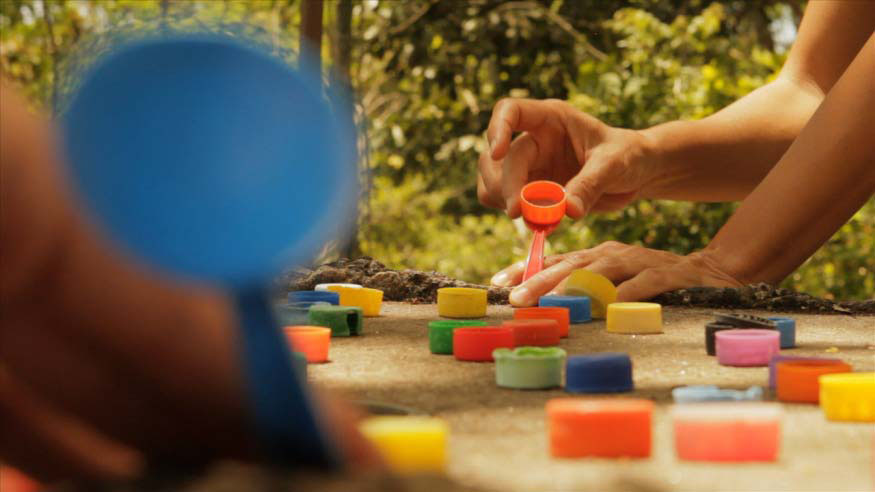
© » KADIST
Donna Conlon and Jonathan Harker
In Tapitapultas (2012), Donna Conlon and Jonathan Harker comment on mass consumerism and pollution by way of a game they invented. The artists used disposable spoons as catapults to shoot thousands of plastic bottle caps at a hole in a concrete platform. The platform was once part of a U. S. military installation in the Panama Canal Zone, and it is now an observation deck in a nature park.

© » KADIST
Bárbara Wagner & Benjamin de Burca
Originally commissioned for the 32nd Sao Paulo Biennial, the film Estás vendo coisas (You are seeing things) depicts the subculture of Brega music, a fusion of American Hip Hop, Brazilian techno and Caribbean reggaeton that emerged in North Eastern Brazil over the last decade. Part anthropological documentary and part musical the film speaks about the realities of Brazil with its enormous social and economic tensions.
Richard Gordon
Originally from Chicago, Richard Gordon was a self-taught photographer best known for his intelligent and masterfully printed black-and-white photographs...
James T. Hong
James T...
Kara Walker
- location: New York, New York
- year born: 1969
- gender: female
- nationality: American
- home town: Stockton, California
Sharif Waked
Sharif Waked is a Palestinian artist who’s work enages with with Islamic culture and history, and its interaction with the Israeli occupation and hegemonic Jewish culture in Palestine...
Richard T. Walker
- location: San Francisco, California
- year born: 1977
- gender: male
- nationality: British
Finger Pointing Worker
“Finger Pointing Worker” is a man who pointed at the public live camera in Fukushima nuclear power station after the disaster in 2011...
Donna Conlon and Jonathan Harker
- location: Panama City, Panama
- year born: 1966
- nationality: American and Ecuadorian
Richard Bell
Richard Bell works across a variety of media including painting, installation, performance and video and text to pose provocative, complex, and humorous challenges to our preconceived ideas of Aboriginal art, as well as addressing contemporary debates around identity, place, and politics...
Kelley Walker
- location: Columbus, United States
- year born: 1969
- gender: male
- nationality: American
Volker Eichelmann
Volker Eichelmann (b...
Evariste Richer
Evariste Richer constantly invents new standards for measurement which are mostly objects to prompt the spectator’s potential investigations: avalanche probes, a meter drawn from memory, a meter with no measurements… Meteorology, science, magic, mineralogy, photography, optics are his preferred terrains...
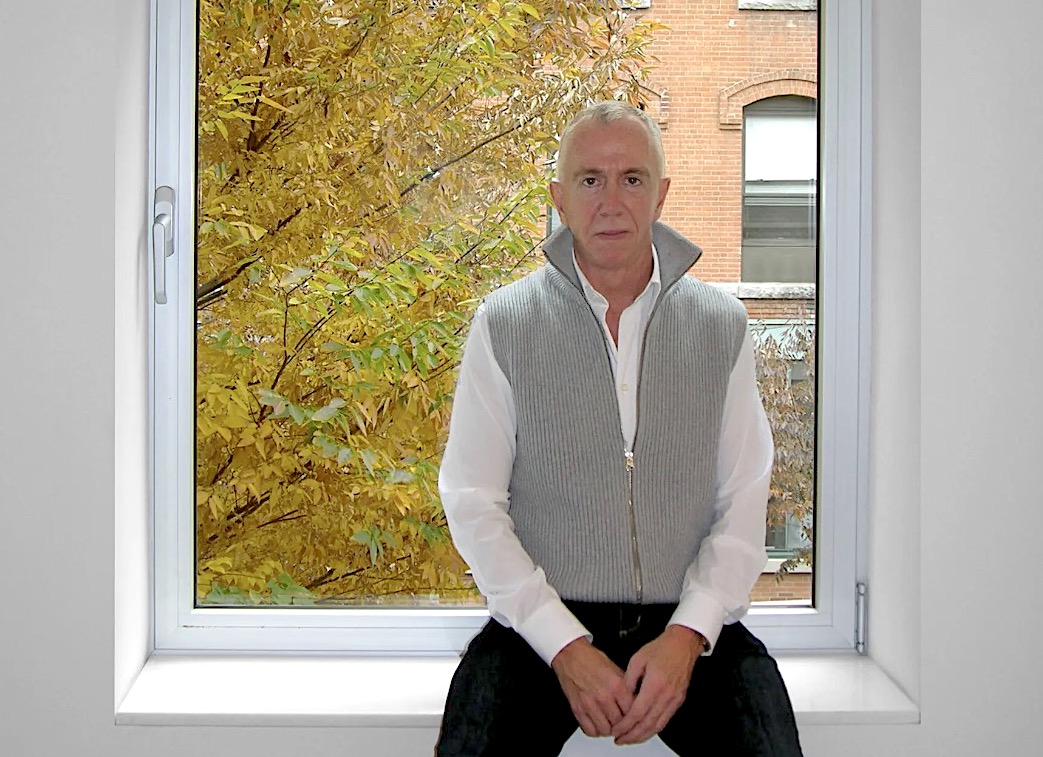
© » ARTLYST
about 3 months ago (01/17/2024)
Brent Sikkema, the Manhattan art dealer renowned for representing artists such as Jeffrey Gibson and Kara Walker found dead The post Brent Sikkema – Visionary Art Dealer Of Jeffrey Gibson And Kara Walker Murdered appeared first on Artlyst ....
-
2000-2009
Richard Gordon
2003San Francisco, Moscone Center is a silver gelatin print from the series American Surveillance , a ten-year-long project where Richard Gordon photographed surveillance cameras across USA...
Kelley Walker
2004The triptych Black Star Press is part of the series ‘The Black Star Press project’ initiated in 2004 by the American artist Kelley Walker...
Kara Walker
2005In her masterpiece 8 Possible Beginnings or The Creation of African-America , Walker unravels just that, the story of struggle, oppression, escape and the complexities of power dynamics in the history following slave trade in America...
Evariste Richer
2008Cumulocumulonimbus capillatus incus functions on the mode of a mise en abîme: it is a cube composed with 8000 dice...
-
2010-2019
Finger Pointing Worker
2011During Summer 2011, few months after the nuclear accident, performance artist Kota Takeuchi got a job at the Fukushima Daiichi plant and kept a blog about the labour conditions of clean-up workers...
James T. Hong
2012Taiwan WMD (Taiwan and Weapons of Mass Destruction) is part of a long-term research started in early 2010 on the history and aftermath effects of Japanese biological and chemical warfare in China during WWII, as well as the unknown history of Taiwan’s nuclear program...
Sharif Waked
2012Bath Time by Sharif Waked is a short video based on the tragi-comic outcome of the Israeli Blockade and the wars in Gaza...
Donna Conlon and Jonathan Harker
2012In Tapitapultas (2012), Donna Conlon and Jonathan Harker comment on mass consumerism and pollution by way of a game they invented...
Sharif Waked
2013Tughra is a protocol by Sharif Waked that reproduces the sixteenth century calligraphic monogram for tughra ; also known as the signature of Suleiman the Magnificent...
Volker Eichelmann
2014In his new series of collages, Eichelmann takes his starting point from the “Belvedere Torso” in the Vatican Museum...
Bárbara Wagner & Benjamin de Burca
2016Originally commissioned for the 32nd Sao Paulo Biennial, the film Estás vendo coisas (You are seeing things) depicts the subculture of Brega music, a fusion of American Hip Hop, Brazilian techno and Caribbean reggaeton that emerged in North Eastern Brazil over the last decade...
-
2020-2029
Richard Bell
2022For Richard Bell, art is not simply a vehicle through which to represent and convey political content...